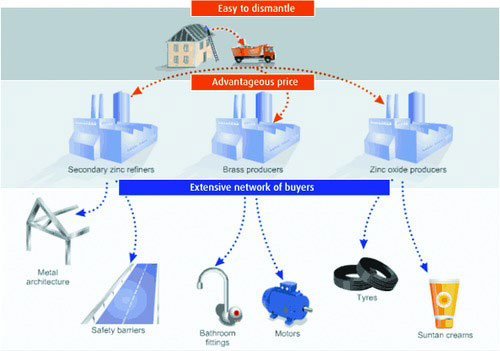Zinc Roofing and Wall Systems
Recyclability
Very few common building materials, including those considered to have low embodied energy, can match the recyclability of zinc material. Architectural-grade zinc must be very pure, and so it contains higher percentages of pure ore than industrial-grade zinc. However, once the pure architectural alloy has been created, it can be recovered and reprocessed for use in new architectural products. Zinc is 100 percent recyclable and in Europe 95 percent is recovered during demolition or renovation work. Used rolled zinc is re-used in different applications including brass production and foundries. With this exceptional level of recycling, in environmental terms, rolled zinc is one of the most efficient materials among the metallic solutions used for building envelopes.
Durability
Since zinc is a non-ferrous metal, it is not subject to the rust and corrosion found in iron, steel, and other ferrous materials. According to the International Zinc Association's “Zinc for Life” program, “Zinc material requires little maintenance over its service life; its (natural) patina constantly renews itself as it weathers and ages and will 'heal over' scratches and imperfections, requiring no touch-up or repainting. Because the metal is uncoated, there is no possibility of the fading, chipping or peeling that otherwise needs recurrent attention. A single zinc roof, with a lifespan of 80 to 100 years may well outlast the building it has been sheltering.” It should be noted that wall panels using zinc, without the environmental rigors of roofing applications, may have service lives of 200 to 300 years, depending on the product used and local conditions. Of course, two obvious factors in the longevity of a zinc application are the quality of installation and experience of the installer. By working closely with a manufacturer's representative and adhering to guidelines, building owners and managers can avoid corrosion and other issues that might negatively affect maintenance and longevity.
Ability to Recover and Recycle at End of Useful Life
Removal and disposal of typical building materials can be a complex and costly job, and the resulting debris may have low or no value ending up in a landfill producing the associated costs for freight and disposal plus the long-term cost to the environment. However, of the millions of tons of discarded building materials taken to landfills every year, there is hardly a scrap of architectural zinc. This is because metallic zinc can be recycled indefinitely without loss of its chemical or physical properties. This theoretically infinite recyclability is, in fact, being approached in reality in the case of zinc used in buildings. The overall recycling rate for architectural zinc recovered from renovations and removal from old building is over 90 percent in some countries because of its high value. In Europe, buildings whose zinc parts outlasted them are numerous yet virtually no zinc on a building ever goes to a landfill. Recycling of zinc is a well-established industry because products can be recovered easily at the end of their life and there is an extensive network of buyers offering advantageous prices.
 |
Photo courtesy of VM Zinc, USA The ability to recycle and re-use zinc at the end of the service life of a building. |
Reducing Construction Waste
The standardization of sizes of zinc products means that less cutting and scrap material may be produced during any given project. Nonetheless, any zinc construction wastes can easily be separated from other metals and sent to any local metal scrap dealer. In the United States, zinc is commonly reused by the galvanization industry or may be fabricated into other products such as paints and sunscreen. Even small amounts of scrap zinc generated on jobs are valuable and readily sold.
Selecting Low-Emitting or No-Emitting Materials
Part of the beauty of zinc metal comes from its natural coloration which means that no additional paints, sprays, or other treatment is needed. As a result, manufacturers, fabricators, installers, and users will never need to apply any other coatings on the metal. Consequently, no Volatile Organic Compounds (VOCs) ever need to be introduced that might generate emissions which are contrary to healthy indoor environmental quality.









